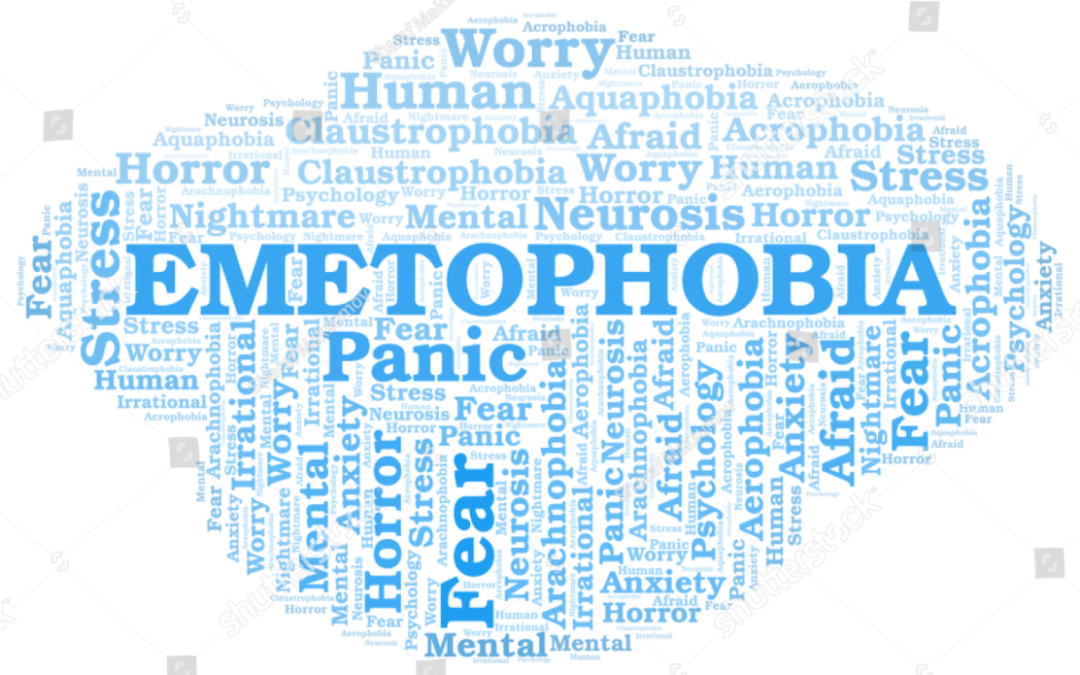How to overcome emetophobia
It’s not just you who has emetophobia!
Emetophobia is without doubt the most common phobia we are asked to work with. Not a day goes by in our office without enquires from people who are suffering with this phobia.
Many people with emetophobia believe they are on their own, and that their case is the severest we may have come across. However we have worked with emetophobia frequently for many, many years and have been faced with people whose emetophobia has rendered them:
House bound for over 25 years
Women who have never been able to have children due to the prospect of morning sickness
Many who have burnt their stomachs from hot water bottles, become malnourished due to the fear of food inducing sickness
A lady who had only 4 teeth left after all the others had rotted due to sucking mints to counteract nausea.
Of course, these are just a few of the hundreds of cases we have been faced with. Symptoms and severity vary greatly. However as emetophobia has a habit of progressing and additional rituals added over time, it is advisable to obtain therapy. Personally start to challenge your beliefs as soon as possible to prevent the effects of emetophobia magnifying.
Frequent Symptoms & Rituals
There’s many symptoms and rituals associated with a fear of vomit, and these can include the following fears:
Certain foods such as chicken
Fish or food prepared by others such as in a restaurant or take away
Medical establishments where sickness may be prevalent
Children and schools where bugs and sickness may occur
Alcohol
Coming into contact with people generally
Objects that could cause cross contamination
Travel should motion sickness occur, a fear of pregnancy, obsessive cleaning, obsessive washing, over use of antibacterial products, excessive use of hot water bottles, excessive mint sucking or hot tea to name but a few.
Causes of Emetophobia
No one is born with a phobia. Therefore all phobias, including emetophobia, are learned either by copying behaviour or due to a negative life experience. Most often in childhood, where the experience creates a heightened state of emotion, and the sufferer feels scared, vulnerable, and or in a position of danger.
These negative circumstances, when the belief is created most often in early years, is based on a child’s interpretation. They witness vomiting, and interpret it the same as a violent or life threatening event. This inaccurate interpretation creates an inaccurate schema (belief) which develops into a phobia. A phobia is a huge protection mechanism against a ‘perceived’ but not real danger. This is why phobias are often referred to as an ‘irrational’ fear, as they are not based on fact.
In our clinic, we have found the two main contributors to the start of emetophobia are either the sufferer seeing a parent or loved one being sick at an age where they are too young to understand, believing that their loved one could be dying. The other is the sufferer themselves being sick, and their parent or responsible adult not dealing with the situation calmly. Obviously there are other circumstances, however these appear to be the most common.
Can Emetophobia be treated?
There are two types of phobia. One being a ‘simple phobia’, where the phobia relates to a single trigger, or a ‘complex phobia’ – where numerous triggers are prevalent. Most simple phobias can be dealt with within one therapy session. However emetophobia is a complex phobia. Iit has numerous triggers and rituals often orientating around certain foods, drinks, venues, circumstances, cleaning rituals, ailments, avoidance and contingencies.
As a result of the numerous elements prevalent in emetophobia, often more than one session is required to completely address and remove all triggers. Progress can be monitored and documented between sessions and later resolved.
How can I overcome Emetophobia?
The right therapy and therapist can help you to overcome emetophobia successfully.
In our clinic, we personally do not find hypnotherapy or EFT (tapping) effective with emetophobia. However, EFT can help in the moment as a distraction. This does not mean you should not try these options, as it may work for you. However Cognitive Behavioural therapy, Psychotherapy, Counselling and Neuro Linguistic Programming can work if delivered by the therapist in an effective way, thus allowing you to change.
Schema Conditioning Psychotherapy™ which we have developed is fast and effective, and very successful with treating emetophobia. Due to demand, we are hoping to train others in our Schema Conditioning Psychotherapy™ in the near future so many more people can benefit from our therapy process.
How can I help myself?
Do always consult your GP about your condition. The following tips may help you to overcome or significantly alleviate your emetophobia symptoms, however you must be prepared to put the effort in. You cannot expect to attend a gym once and be fit for life, which is similar when personally trying to overcome a phobia.
In the absence of intensive therapy, you will need to work on changing your current belief which is entirely possible if you are truly ready to challenge emetophobia once and for all.
Ask yourself, is your fear real in the world? Or real just to you? Does the entire world fear vomit (as in a very real danger that humanity is warned of) or is it just real to you? Consider how many people in your close circles have this fear? If it is just real to you, then ask yourself have you got it right or wrong? If you believe you have got it right you are not yet committed to change, however read on as this may help to encourage you. If you believe you have got it wrong and your current belief is incorrect, this is a huge step toward change.
Try and understand what event started your emetophobia. Whatever you saw or experienced as a child, revisit the memory. Ask yourself if you were to see that today as an adult WITHOUT emetophobia, what is the reality of that situation? Did anything really bad happen? Was vomit to blame for creating the situation, or was it actually the fault of someone or something else? Eg. alcohol or an adult reacting incorrectly etc.
Discuss the starting event with a friend or someone you trust. Ask them had they seen or been involved in that situation, what would it have meant to them? How would they have interpreted it? How would they have reacted and why? (This is to assist you to collate opposing evidence to your current belief).
See the starting event as a third party. This means observe it like a movie as opposed to being in the movie. Change the movie to black and white, and then watch it backwards a few times from end to start with everything going backwards.
People suffering with emetophobia invariably look for evidence as to why they should keep their phobia. Such as news articles of viruses and bugs, and of people who may have choked on vomit. The purpose of this is to try and convince yourself that you are justified to have your fear. Repercussions of your fear are detrimental to you and your loved ones. You need to cling to possibilities to excuse your beliefs and rituals towards vomit. You now have to challenge yourself EVERY DAY as to why vomit is positive. Such as – vomit is my body’s first line of defence to remove toxins. Vomit is induced to save lives if people have swallowed something that could poison or kill them. Animals induce vomit by eating grass to cleanse their stomachs. Babies vomit often and are un-phased and survive etc.
Challenge Your Beliefs
Challenge your beliefs and rituals, for example: ‘I’m scared of going in to hospitals as I may catch something that will make me sick’. Consider, what is the purpose of a hospital? To hurt or save a life? Ask yourself, is my belief true or false? If false, do I want to continue to believe something that is not true? ‘I can’t be around people or children who could be sick’. Consider, what kind of people does a GP see every 10 minutes in the confines of his or her treatment room? Healthy people or sick people? Are GPs generally healthy or sick? GPs are generally healthy because they are surrounded by sick people which builds their immunity. It makes them stronger and THEY ARE NOT SICK.
Step out of your comfort zone a little every day. For example if you compulsively wash, remind yourself that over washing damages the natural oils in the skin that naturally protect us. Damaging and washing away the natural oils causes skin to crack and therefore open you to the elements, thus actually exposing you more than if you wash moderately.
Tell the people around you, who know about your phobia, that you are now on a mission to conquer your fear and they must show tough love by not accommodating any of your emetophobia based demands. They must just firmly and lovingly remind you that you as an adult, you are taking control, and not the child that created the inaccurate belief.
There will be times when you have to take a deep breath and have stern words with yourself. But remind yourself, the reason the belief doesn’t serve you in adulthood is because it was created by a child. Don’t be cross at the child, but understanding that little ones often get things wrong and mixed up in the moment. Remind yourself that it was a fear set up out of confusion and fear, but not out of fact, and as an adult, you will no longer take direction on how to react to vomit from a child. Acknowledge gratitude and understanding for the child’s endeavours to protect you, albeit the protection was set up inaccurately so as an adult you give yourself permission to let it go.
Sonia’s Story
Finally, a little advice for you to consider, from a lady who used to have emetophobia. From being 4 years of age Sonia has had a fear of sickness. After having had two children and seeing the devastation her phobia was causing to her partner, family, children and self, one day Sonia said enough is enough. She decided that if she felt sick she would let it happen. She told herself she was fearing the unknown as she’d actually never been sick in adolescence or adulthood. Sonia was angry, desperate and in ‘fight mode’.
Sometime later, Sonia felt sick and willed herself to be sick. She was terrified and in floods of tears, but willed it all the same as she could no longer allow the thing she feared to dominate her life. Eventually Sonia was sick. It was then she realised she didn’t die. Nothing horrific happened! She realised it was unpleasant, but it wasn’t horrific. She survived and now tells her children, don’t worry if you’re sick. It’s not very nice, but it’s not horrid.
As therapists, we wish you strength in overcoming your emetophobia. We hope you too can realise that like Sonia said, it’s not pleasant, but it’s not horrific. Congratulations on wanting to take action to gain control from something you don’t want in your life. We very much hope that today is your day to say enough is enough and I will do whatever it takes to put emetophobia behind me once and for all.
Do not be afraid or ashamed to talk about emetophobia. You are not alone, and this phobia like every other phobia can be overcome with a little work to challenge the incorrect schemas/beliefs. Check out our trilogy of videos about emetophobia on our TikTok channel for more of a deep dive plus some helpful tips!

